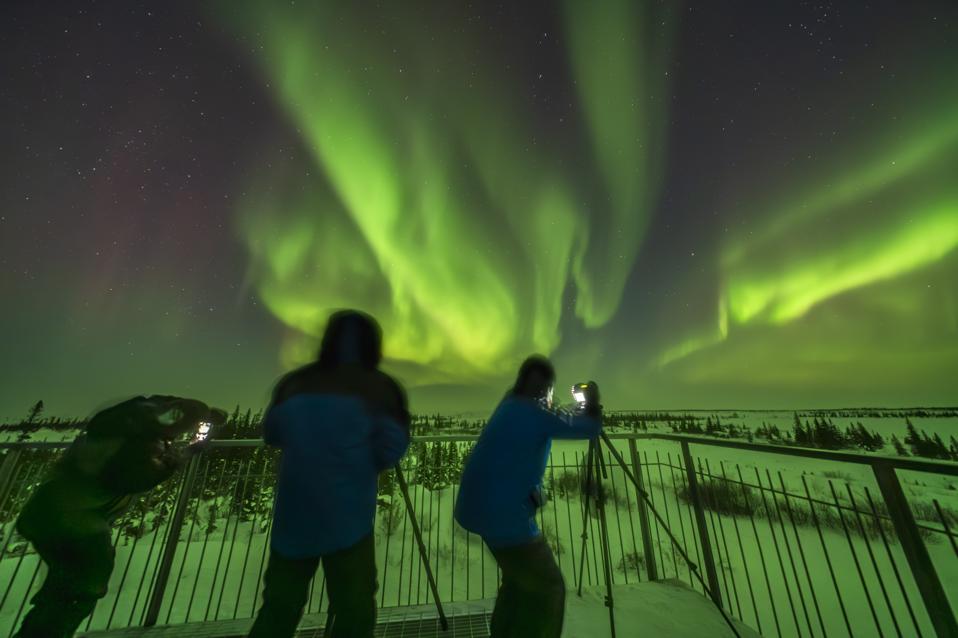
A group of photographers is capturing a bright display of Northern Lights at the Churchill Northern Studies Centre, near Churchill, Manitoba. (Photo by: Alan Dyer/VWPics/Universal Images Group via Getty Images)
VW Pics/Universal Images Group via Getty Images
The Northern Lights may be visible across 12 northern U.S. states and Canada as soon as it gets dark on Wednesday, Oct. 29, 2025, according to a forecast from the National Oceanic and Atmospheric Administration’s Space Weather Prediction Center (SWPC). The forecast includes a G1-rated geomagnetic storm that could see displays of aurora.
The forecast comes in the wake of visible auroras across northern latitudes in the past few nights, after a coronal mass ejection — a cloud of super-charged particles that leaves the sun and takes a few days to reach Earth — began interacting with Earth’s magnetic field, followed by fast-moving solar wind.
Northern Lights Forecast: What To Expect
NOAA forecasters say the impact may be a G1-rated geomagnetic storm resulting in auroras for northern U.S. states, Canada and northern Europe.
“Unsettled to active conditions are expected through 31 Oct, with G1 (Minor) storming likely on 29-30 Oct, due to persistent CH HSS effects,” reads the forecast. CH HSS refers to a coronal hole, which allows high-speed solar wind to escape from the sun, sometimes in the direction of Earth. That means turbulence, which heightens the chances of Northern Lights.
Northern Lights Forecast: Where And When
NOAA’s latest aurora viewlines indicate that aurora displays are a possibility in northern U.S. states and Canada, with 12 U.S. states having a chance after dark on Wednesday, Oct. 29. Intensity levels could reach Kp 5 — an active level of space weather — as soon as it gets dark in North America, and remain all night.
U.S. states that may see aurora include Alaska and (northerly parts of) Washington, Idaho, Montana, Wyoming, North Dakota, South Dakota, Minnesota, Wisconsin, Michigan, New York and Maine.
Dark northern skies away from urban light pollution are likely to offer the best views. Useful ways to locate a dark place are the Dark Sky Place Finder and a light pollution map.
NOAA’s aurora viewline for Wednesday, Oct. 29. 2025.
NOAANorthern Lights Forecast: Latest Updates
All forecasts for the aurora must be treated with caution. To check visibility in real time, use NOAA’s 30-minute aurora forecast, or download apps such as Aurora Now, My Aurora Forecast or Glendale Aurora for up-to-the-minute alerts and live solar wind data.
Northern Lights Forecast: How To Photograph Aurora
A mirrorless or DSLR camera is ideal (ISO 1600, 2-10 seconds, f2.8), though newer smartphones are increasingly capable of stunning results. If your smartphone has a Night Mode or Pro Mode, you can capture a beautiful aurora photo with these steps:
Use your main lens, not the ultra-wide, for sharper results.Stabilize the camera using a tripod or rest it on a firm surface such as a car roof, wall, or post.Shoot in RAW format if available, as it allows easier post-editing.Expect long exposures between five and ten seconds. Even faint glows that look grayish to the eye often appear vividly green, purple or red in photos.
Wishing you clear skies and wide eyes.

